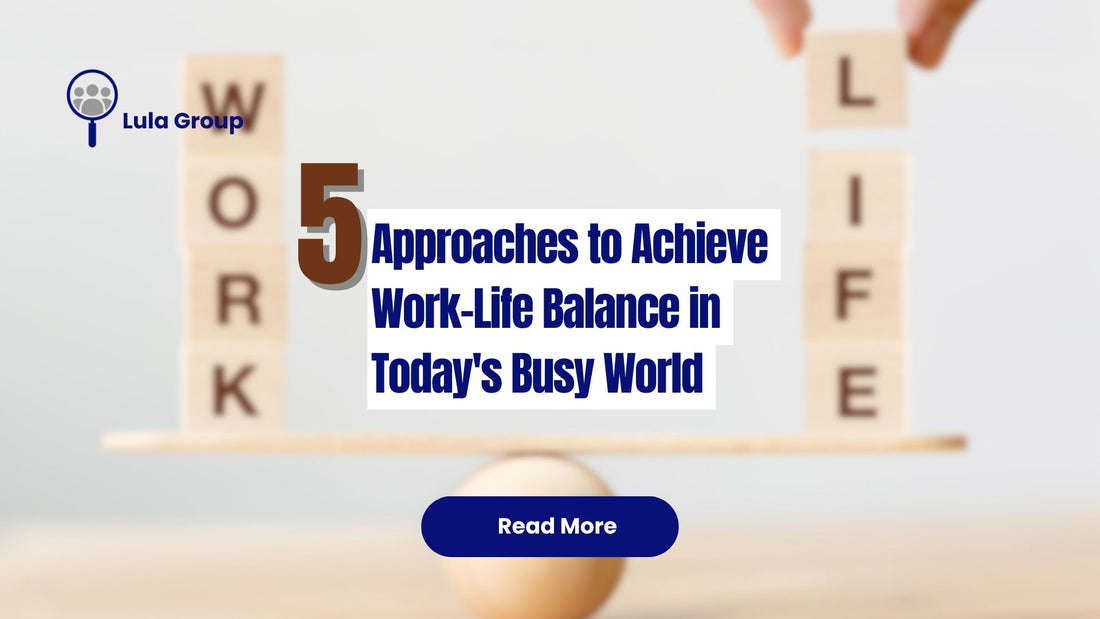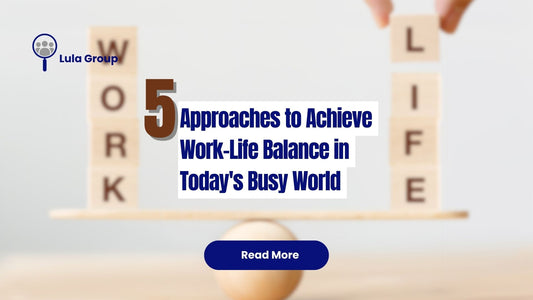Work-life balance is a concept that has gained significant attention in recent years. It refers to the equilibrium between our professional and personal lives, ensuring that both areas are adequately addressed and nurtured.
Achieving work-life balance is crucial for our overall well-being and happiness. In today's fast-paced world, where technology blurs the boundaries between work and personal life, finding this balance can be challenging.
However, with some expert tips and strategies, you can harmonise your life and enjoy the benefits of a well-rounded existence.
The importance of work-life balance
-
According to an OECD survey 13% of employees in Australia work very long hours, which is above the OECD average. And this work-life balance is worse than in many other countries.
-
Work-life balance is essential for maintaining a healthy and fulfilling lifestyle, personally and professionally.
Here are some key reasons why work-life balance is crucial:
-
Physical and Mental Well-being
Striking a work-life balance helps prevent burnout and stress-related health issues. Overworking and constant stress can lead to physical ailments, mental health problems, and decreased overall well-being. Taking time for relaxation, hobbies, and spending time with loved ones contributes to better physical and mental health.
-
Increased Productivity
Working excessively long hours without breaks can lead to diminishing returns in productivity. When you prioritise work-life balance, you're more likely to approach tasks with a clear mind, heightened focus, and increased creativity. Balanced individuals tend to be more efficient and effective in their work.
-
Enhanced Job Satisfaction
A healthy work-life balance contributes to job satisfaction. When you have time to pursue personal interests and spend time with family and friends, you return to work feeling refreshed and motivated.
-
Stronger Relationships
Balancing work and personal life fosters strong relationships with family and friends. Quality time spent with loved ones helps build emotional connections and provides much-needed support. Maintaining these relationships can enhance your overall sense of happiness and well-being.
-
Personal Growth
Pursuing interests outside of work allows for personal growth and development. Engaging in hobbies, learning new skills, and participating in activities you enjoy contribute to a well-rounded and fulfilled life.
-
Reduced Stress
Chronic stress from an imbalanced lifestyle can lead to emotional exhaustion, anxiety, and depression. Prioritising work-life balance helps manage stress levels, leading to improved mental health and emotional resilience.
-
Prevention of Burnout
When work takes over your life, burnout becomes a real risk. Maintaining a work-life balance helps prevent burnout, allowing you to sustain your career in the long term.
-
Overall Fulfilment
Ultimately, work-life balance contributes to a sense of fulfillment and happiness. When you juggle your career with your personal life, you're more likely to experience a sense of accomplishment, purpose, and contentment.
The challenges of achieving work-life balance in a fast-paced world
1. Constant Connectivity
The advent of technology has made it challenging to disconnect from work. Emails, messages, and notifications can invade personal time, blurring the boundaries between work and leisure.
2. Increased Workload
Many professionals handle larger workloads due to organisational restructuring, downsizing, or increased responsibilities. This can lead to longer working hours and less time for personal activities.
P.S. Are you looking for a new career opportunity? Let us help you. Apply for our exclusive positions online through the "Find a job" page.
3. High Expectations
The expectation to always be available and responsive, regardless of the time or day, can create immense pressure. This can make it difficult to disengage from work-related tasks, even during personal time.
4. Remote Work Challenges
While remote work offers flexibility, it can also lead to difficulties setting clear boundaries between work and personal life. The absence of physical separation between the two environments can lead to constant multitasking.
5. Career Ambitions
Ambitious career goals can lead you to prioritise work over personal life. The desire to succeed and climb the corporate ladder may result in longer hours and less time for relaxation.
6. Fear of Missing Out (FOMO)
The fear of missing out on career opportunities, promotions, or crucial work-related discussions can deter individuals from stepping away from work commitments, even during personal time.
7. Parental and Caregiver Responsibilities
Balancing work with family responsibilities, such as childcare or caring for elderly parents, can be particularly challenging. Juggling both roles often requires careful planning and support.
8. Workaholic Culture
Some work environments promote a culture of long hours and overwork as a measure of dedication. This can lead to individuals feeling pressure to conform and work excessively.
Also read: Five signs of an unhealthy workplace environment
Tips for setting boundaries and managing priorities
Setting boundaries and managing priorities are essential steps in achieving work-life balance. Firstly, it is crucial to clearly define your work hours and communicate them to your colleagues and superiors.
This will help establish expectations and ensure that your time is respected. Learn to say no when your workload becomes overwhelming or additional tasks are not aligned with your priorities.
Prioritising tasks and focusing on the most important ones will help you manage your time more effectively and prevent burnout.
Time management techniques for work-life balance
Effective time management techniques contribute to achieving work-life balance. Here are some techniques to help you manage your time more efficiently:
1. Pomodoro Technique
Set a timer for a focused work session, typically 25 minutes, followed by a short break of 5 minutes. After completing four sessions, take a longer break of 15-30 minutes. This technique boosts productivity and prevents burnout.
2. Time Blocking
Allocate specific blocks of time for different tasks or activities. This helps you stay focused on one task and prevents multitasking.
3. Eisenhower Matrix
Categorize tasks into four quadrants: urgent/crucial, important/not urgent, urgent/not crucial, and neither urgent nor crucial. Focus on the tasks in the crucial/urgent quadrant.
4. Batching Tasks
Group similar tasks together and complete them during designated time blocks. For example, respond to emails or make phone calls in batches to minimise context switching.
5. Eat the Frog
Start your day by tackling the most challenging or important task first. This sets a productive tone for the rest of the day.
6. Use a To-Do List
Create a to-do list for each day, prioritising tasks based on their importance and deadlines. Cheque off completed tasks to track progress.
7. Limit Multitasking
Focus on one task at a time to improve efficiency and reduce errors. Multitasking can lead to decreased productivity and increased stress.
8. Automate Repetitive Tasks
Use automation tools for routine tasks like sending emails, scheduling appointments, or posting on social media.
Incorporating self-care into your routine
Self-care is an integral part of achieving work-life balance. It involves taking care of your physical, mental, and emotional well-being.
Incorporating self-care activities into your routine can help you recharge and rejuvenate, enabling you to perform at your best in your personal and professional life.
This can include exercise, meditation, spending time with loved ones, pursuing hobbies, or simply taking breaks throughout the day to relax and recharge.
Prioritising self-care may require setting boundaries and saying no to additional commitments, but it is crucial for maintaining a healthy work-life balance.
Strategies for effective communication and delegation
Effective communication and delegation are essential for achieving work-life balance. Communicating your needs, boundaries, and concerns to your colleagues and superiors can help establish a supportive work environment.
Express your limitations and seek assistance or delegation when necessary. Learning to delegate tasks to others can alleviate your workload and create opportunities for personal time.
Building relationships with your colleagues and superiors based on open and honest communication will create a supportive work environment that promotes work-life balance.
Tools and resources for achieving work-life balance
There are various tools and resources available to help you achieve work-life balance by managing your time, tasks, and well-being.
Time Management Tools:
1. Todoist
2. Trello
3. Asana
4. Notion
5. Focus@Will
Calendar and Scheduling Tools:
3. Calendly
4. Fantastical
Health and Wellness Tools:
1. Headspace
2. Calm
3. MyFitnessPal
4. Fitbit
Communication and Collaboration Tools:
1. Slack
3. Zoom
Distraction Management Tools:
2. Freedom
3. StayFocusd
In conclusion, achieving work-life balance is vital for leading a fulfilling and well-rounded life. It requires understanding the importance of work-life balance, recognising the challenges in a fast-paced world, and implementing expert tips and strategies.
Remember, work-life balance is a continuous journey that requires ongoing effort and adjustment. By prioritising this balance, you can enjoy a more fulfilling and satisfying life personally and professionally.
Reach out to us for professional guidance and take the first step towards harmonising your life and enjoying the benefits of a well-balanced existence.




